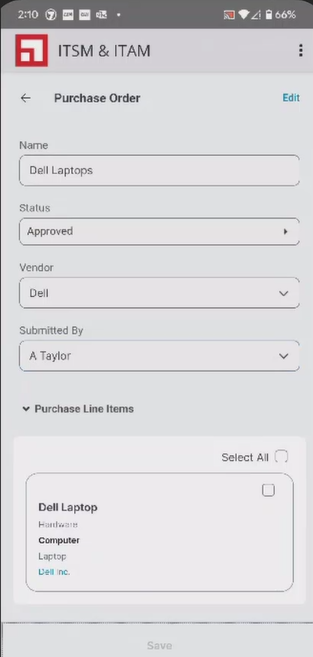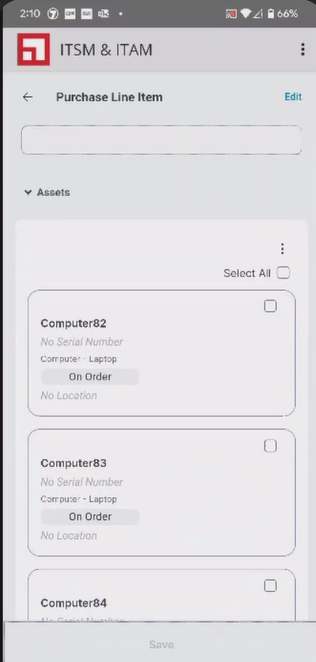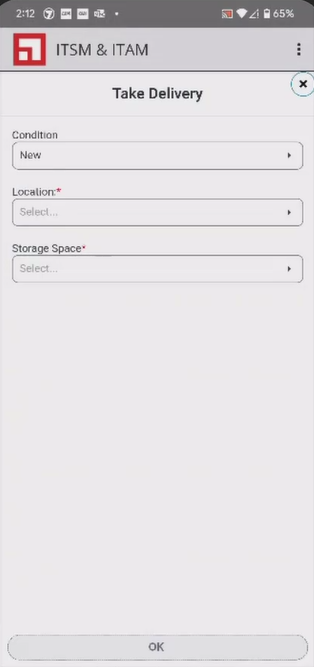Procurement
The Procurement Manager and Storage Manager user roles have access to a set of workspaces that help you to manage the procurement of assets. Assets are procured, either from the Product Catalog or as a custom purchase, using a purchase order.
The Asset Administrator or Asset Manager roles also have access to these workspaces.
There are three levels of procurement available to you, each of which enables you to take delivery of assets in a controlled manner by recording further information:
•Purchase Orders – The most basic level is to use only purchase orders to manage your procurement. You can record information about the purchase order, including the vendor and the total cost.
•If your organization is using the Ivanti Service Manager app for Android- and iOS-based smartphones, users with the role of Mobile Asset Manager can take delivery of assets that are line items of a purchase order. Use the app to scan asset barcodes into the database from the point of delivery. For details, see the section below.
•Invoices – You can associate one or more invoices with a purchase order. This helps you to track the invoices from your vendor and highlights any differences between the total cost from all of the invoices and the expected cost that was recorded on the purchase order.
•Shipments – You can associate one or more shipments with an invoice. This helps you to track the shipments associated with an invoice. You can record shipping and tracking details, as well as the destination location and storage, all of which streamline the process for taking delivery of the assets.
The Product Catalog is a list of standard assets that have approved vendors who will supply these assets at an agreed cost—this makes acquiring an asset much simpler when filling out a purchase order. If an asset is not in the Product Catalog, you must complete additional steps below for each request.
1.Open the Purchase Orders workspace and click New.
2.The Requisition Number is automatically added for you. Enter the Purchase Order number if you know it; otherwise, enter it at a later date. Enter data into the fields for Submitted By, Date Submitted, Name, and Vendor. Note that the vendor is required if you want to associate a contract with a line item in this order. Click Save.
3.Under the Line Items tab, click the New Line Item drop-down and select if you want to add a consumable, hardware, or software line item to this purchase order.
•Select the Catalog Item if the item is in the Product Catalog—the fields will auto-fill with any defined data. Otherwise, complete the fields as needed. Item Name is required for consumables. Item Name, Type, and Sub Type are required for other hardware. Enter a Quantity for the number of these items and Cost Per Unit. The product automatically calculates the Total Cost.
•Enable the Create Asset or Create Consumable check box if you want to create template records of this line item. The number of template records created will be determined by the entered quantity.
About the Create Asset or Create Consumable check boxes:
If you're adding a hardware or consumable line item, but don't yet want to create template asset records for it, clear the Create Asset or Create Consumable check box. Once the hardware or consumable has been purchased, you can reopen the line item here or in the Purchase Line Item workspace and enable the relevant check box, which will create the asset records in the Hardware Assets workspace.
Clearing Create Asset or Create Consumable is also useful for situations where you already have an asset record defined, but you're wanting to retroactively track it as a line item in a purchase order. For such items, you can manually link to the existing asset record from the Assets tab.
•For hardware, you can search for an existing Contract or create a new one to add. Note that available contracts are those associated with the vendor selected for this order. You can search for an existing Contract Line Item or create a new one to add. Available line items are those associated with the selected contract.
•Click Save. The line item is added to the Line Items tab, and any contract line items you added display under the Associated Contracts tab. Also, the purchase order displays under the Purchase Orders tab for the corresponding contracts and contract line items, and the contract line item displays under the Contracts tab of any asset records created from the purchase order.
4.Add more line items to this purchase order as needed.
5.Next, complete the other associated tabs as needed:
•Vendor Details – View vendor details here and click Go to to view this vendor record in the Vendors workspace.
•Vendor Scorecards – View existing scorecards for this vendor or create a new one relating to performance for this order.
•Assets – Link to assets that fulfill this order. Linked asset records will show the details of the order under their Finance tab in the Hardware Assets workspace.
•Invoices and Shipments – See the sections below for details.
• Asset Requests – If this order is part of a customer asset request, link to that request. Linked request records will show the details of the order under their Purchase Order tab in the Asset Requests workspace.
•Task – Add and manage any tasks that are part of this order. When adding a task to an order, you assign it to a team. The task status is set to Logged, and an email is sent to the team owner. As the task progresses, you can update the status from this tab. Asset Administrators can also manage outstanding tasks in the Tasks workspace.
•Journal – Add emails or notes to this order.
•Attachments – Attach a document to this order, or add a URL link to a relevant website. URLs must include the https:// prefix.
•Associated Contracts – If this order contains line items from the Product Catalog, there may be vendor contracts associated with that item. To view an associated contract, select one and click Go to.
•Audit History – Automatically tracks any changes made to key attributes of this order.
6.If you think you'll want to add more line items later, click Save.
-Or-
If you're finished adding all line items to this order, click Submit. After submission, the status will change to Approved and you can no longer add line items. Line items added here will also display in the Purchase Line Item workspace.
After submitting the order (and refreshing the display):
•If you added a purchase order number, template asset records for the ordered items are created with a status of On Order. (The number of template records created is determined by the quantity entered above.) These display under the Assets tab of the purchase order, as well as in the Hardware Assets workspace under the asset type and subtype selected above.
•If you didn't yet add a purchase order number, template asset records for hardware or consumables will not be created until you assign a purchase order number to the request and click Save again.
By default, when you submit a new purchase order, its status changes to Approved. However, the Asset Administrator can configure the use of an approval process, so that the purchase order is approved only after the majority of the Purchase Order Approvers contact group has approved the item.
1.Click the ![]() icon in the menu bar at the top of the page. The Configuration Console displays in a new browser tab.
icon in the menu bar at the top of the page. The Configuration Console displays in a new browser tab.
2.In the left navigation, expand Build > Global Constants. Look for ivnt_PurchaseOrderThreshold in the list.
3.Double-click in the Value column. Set the number to the number of members you'll assign in step 6 below, then click Save.
4.In the left navigation, expand Configure > Users and Permissions > Groups.
5.Double-click the group called Purchase Order Approvers.
6.Under the Member tab, click Link and select the users you want on the approvers list. Click Select.
7.Click Save and close the Configuration Console. Refresh the Purchase Orders workspace.
Now, when you click Submit when creating a new purchase order, the status changes to Under Review and approval requests are automatically sent out to the appropriate people. When over 50% of the group has approved the item, the approval is completed and the status changes to Approved.
For more information, see Employees, departments, teams, and contact groups.
You can associate one or more invoices with a purchase order to help you to track the invoices from your vendor and highlight any differences between the total cost from all of the invoices and the expected cost that was recorded on the purchase order.
1.Open the required purchase order, and click the Invoices tab.
2.Click New Invoice. The new invoice dialog displays with the Purchase Order field completed.
3.Enter the Invoice Number from your vendor.
4.Optionally, enter the Invoice Date, Freight Charge, and the Invoice Total, then click Save.
The invoice is added to the purchase order and to the Invoices workspace. The Invoice Total on the purchase order updates to show the sum of the invoice totals from all of the invoices associated with the purchase order.
If the invoice totals from all of the invoices associated with the purchase order do not add up to the Total Cost of the purchase order, the Invoice Total label is highlighted in red.
You can associate one or more shipments with an invoice. Shipments enable you to specify a destination location and storage space for the shipment, so that you don't need to specify this individually for each delivered asset.
Shipments that you add to an invoice also display in the Shipments workspace, where you can manage them.
1.Open the Invoices workspace.
2.Double-click an invoice in the list view to open it.
3.Under the Shipments tab, click New Shipment.
4.Enter the Shipper and Shipment Number that was provided by the vendor.
5.If your shipper has provided tracking information, add the Tracking Number and the URL for their Tracking Site. If the URL to track your shipment is created by appending the tracking number to the URL provided in the Tracking Site field, click the Append Tracking Number to URL check box.
Click Here displays under the Tracking Site field. Clicking this link opens the tracking site in a new tab.
6.Enter the Destination Location and Destination Storage Space.
7.Click Save. The shipment is added to the invoice.
When the ordered assets arrive, you can manage their delivery and storage from the Assets tab on the Purchase Order, Invoice, or Shipment workspace as needed.
1.Open the appropriate purchase order, invoice, or shipment, then click the Assets tab. The template asset records for the ordered items are displayed if you're using a purchase order.
If you're using an invoice or a shipment, link the required assets by clicking Link. You can link all of the assets on a purchase order to an invoice by clicking Add All PO Assets at the top of the form, or you can link all of the assets on an invoice to a shipment by clicking Add All Invoiced Assets at the top of the form.
2.Select the assets that have been delivered and click Take Delivery. You can do this for individual hardware assets and consumables, or on a selection. The enter dialog displays.
The Take Delivery button is available only if hardware assets already have their Serial Number set. To add the serial number, double-click the asset and open the edit dialog. The Take Delivery button is always available for consumables, even though they don't have serial numbers.
3.Use the Condition drop-down to select the condition that the asset was in when you received it.
4.If you're taking delivery from a purchase order or an invoice, set the Location and Storage Space where you've placed the asset, then click OK.
If you're taking delivery from a shipment, these fields are not displayed, as they are populated using the values from the shipment. The Status for the asset updates to In Stock.
Taking delivery via the smartphone app
You can use the Ivanti Neurons ITSM & ITAM smartphone app to take delivery of hardware assets that are line items of a purchase order. Use the app to scan asset barcodes into the database at the point of delivery.
This feature is available as part of the latest version of the app. For details about downloading and setting up the app for use in your organization, see Mobile app.
Getting started
Before you can take delivery via the app, complete the following steps:
•Important: After app setup is complete, contact Ivanti support and ask that they turn on the EnableReceivingNewAssets feature on your ITAM Cloud or On-Premises tenant. You can't take delivery via the app if this feature isn't enabled.
•Ask the Asset Administrator to assign you the Mobile Asset Manager user role to use the app.
•Create and save a purchase order in ITAM with one or more hardware line items as described in the procedure above. When adding each hardware line item, fill in the fields for Item Name, Type, Sub Type, Quantity, and Cost Per Unit. The product automatically calculates the Total Cost. Leave the Create Asset check box selected to create template asset records once the order is submitted.
•Submit the purchase order for approval. This action will update the order to Approved status, and the template asset records will display under the Asset tab with a status of On Order.
•Define a delivery location with a storage space within ITAM. For details on setting up both, see Locations and storage spaces.
Taking delivery
Once the assets are delivered, you can use the app to scan each asset's barcode into the database and take delivery. These actions will update the asset records with a serial number, a new status of In Stock, and a storage location.
1.Open the app on your phone. Enter your Tenant URL, then tap Continue.
2.Log in to an account with the Mobile Asset Manager user role. The home screen displays. Tap Scan Assets.
3.On the resulting page, tap Select Purchase Order and Line Item.
4.On the Currently on Order page, search for the line item of this purchase order by entering key words into the search field. The purchase order information should automatically display. Tap the purchase order you want to view.
5.Scroll down the purchase order and tap Purchase line items to expand all line items associated with this order.
6.Tap a line item, then scroll down and tap Assets to expand all assets associated with this line item. 
7.Tap the check box of individual assets you want to scan (or tap Select all), then tap ![]() > Scan Now to open the barcode scanner.
> Scan Now to open the barcode scanner.
8.Use the scanner to scan each barcode, then tap Done & Scan Next after each scan. Scanned assets with serial numbers will display in the lower half of the screen.
9.Once you're finished scanning, tap Finish Scan. If you get an error message indicating that a record can't be saved because the serial number already exists in the database, it's possible the barcode belongs to a different purchase order. In that case, simply tap Re-Scan to scan a different barcode.
10.To finish taking delivery for this purchase order, tap the check box of individual assets (or tap Select all to take delivery in bulk), then tap ![]() > Take Delivery. Select the asset Condition, the delivery Location, and the associated Storage Space. Click OK.
> Take Delivery. Select the asset Condition, the delivery Location, and the associated Storage Space. Click OK.
If the records were successfully updated, each asset will now have a serial number, a status of In Stock, and a storage location. The updates will display in the app, as well as in the workspaces for Purchase Orders and Hardware Assets. You may need to refresh the workspaces to see the updates.